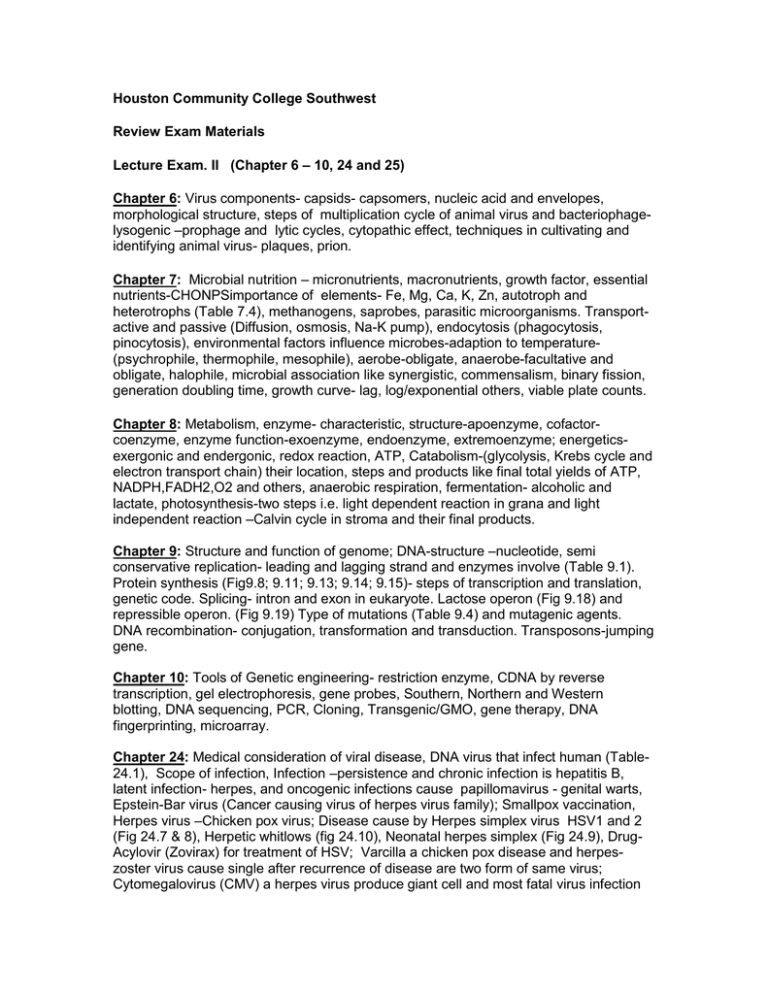2420 review II exam.doc
advertisement

Houston Community College Southwest Review Exam Materials Lecture Exam. II (Chapter 6 – 10, 24 and 25) Chapter 6: Virus components- capsids- capsomers, nucleic acid and envelopes, morphological structure, steps of multiplication cycle of animal virus and bacteriophagelysogenic –prophage and lytic cycles, cytopathic effect, techniques in cultivating and identifying animal virus- plaques, prion. Chapter 7: Microbial nutrition – micronutrients, macronutrients, growth factor, essential nutrients-CHONPSimportance of elements- Fe, Mg, Ca, K, Zn, autotroph and heterotrophs (Table 7.4), methanogens, saprobes, parasitic microorganisms. Transportactive and passive (Diffusion, osmosis, Na-K pump), endocytosis (phagocytosis, pinocytosis), environmental factors influence microbes-adaption to temperature(psychrophile, thermophile, mesophile), aerobe-obligate, anaerobe-facultative and obligate, halophile, microbial association like synergistic, commensalism, binary fission, generation doubling time, growth curve- lag, log/exponential others, viable plate counts. Chapter 8: Metabolism, enzyme- characteristic, structure-apoenzyme, cofactorcoenzyme, enzyme function-exoenzyme, endoenzyme, extremoenzyme; energeticsexergonic and endergonic, redox reaction, ATP, Catabolism-(glycolysis, Krebs cycle and electron transport chain) their location, steps and products like final total yields of ATP, NADPH,FADH2,O2 and others, anaerobic respiration, fermentation- alcoholic and lactate, photosynthesis-two steps i.e. light dependent reaction in grana and light independent reaction –Calvin cycle in stroma and their final products. Chapter 9: Structure and function of genome; DNA-structure –nucleotide, semi conservative replication- leading and lagging strand and enzymes involve (Table 9.1). Protein synthesis (Fig9.8; 9.11; 9.13; 9.14; 9.15)- steps of transcription and translation, genetic code. Splicing- intron and exon in eukaryote. Lactose operon (Fig 9.18) and repressible operon. (Fig 9.19) Type of mutations (Table 9.4) and mutagenic agents. DNA recombination- conjugation, transformation and transduction. Transposons-jumping gene. Chapter 10: Tools of Genetic engineering- restriction enzyme, CDNA by reverse transcription, gel electrophoresis, gene probes, Southern, Northern and Western blotting, DNA sequencing, PCR, Cloning, Transgenic/GMO, gene therapy, DNA fingerprinting, microarray. Chapter 24: Medical consideration of viral disease, DNA virus that infect human (Table24.1), Scope of infection, Infection –persistence and chronic infection is hepatitis B, latent infection- herpes, and oncogenic infections cause papillomavirus - genital warts, Epstein-Bar virus (Cancer causing virus of herpes virus family); Smallpox vaccination, Herpes virus –Chicken pox virus; Disease cause by Herpes simplex virus HSV1 and 2 (Fig 24.7 & 8), Herpetic whitlows (fig 24.10), Neonatal herpes simplex (Fig 24.9), DrugAcylovir (Zovirax) for treatment of HSV; Varcilla a chicken pox disease and herpeszoster virus cause single after recurrence of disease are two form of same virus; Cytomegalovirus (CMV) a herpes virus produce giant cell and most fatal virus infection in human (Fig 24.13); Jaundice is sign of hepatitis virus; Liver cancer cause by hepatitis B; Verrucas known as benign epithelial growth on the skin of finger; Adenovirus cause cold, inflammation of conjunctiva and cornea , hemorrhagic cystitis in children; Parvovirus is unique having single strand of DNA cause erythema infectiousm B19 shows confluent red rash on cheek of children Fig 24.25).



